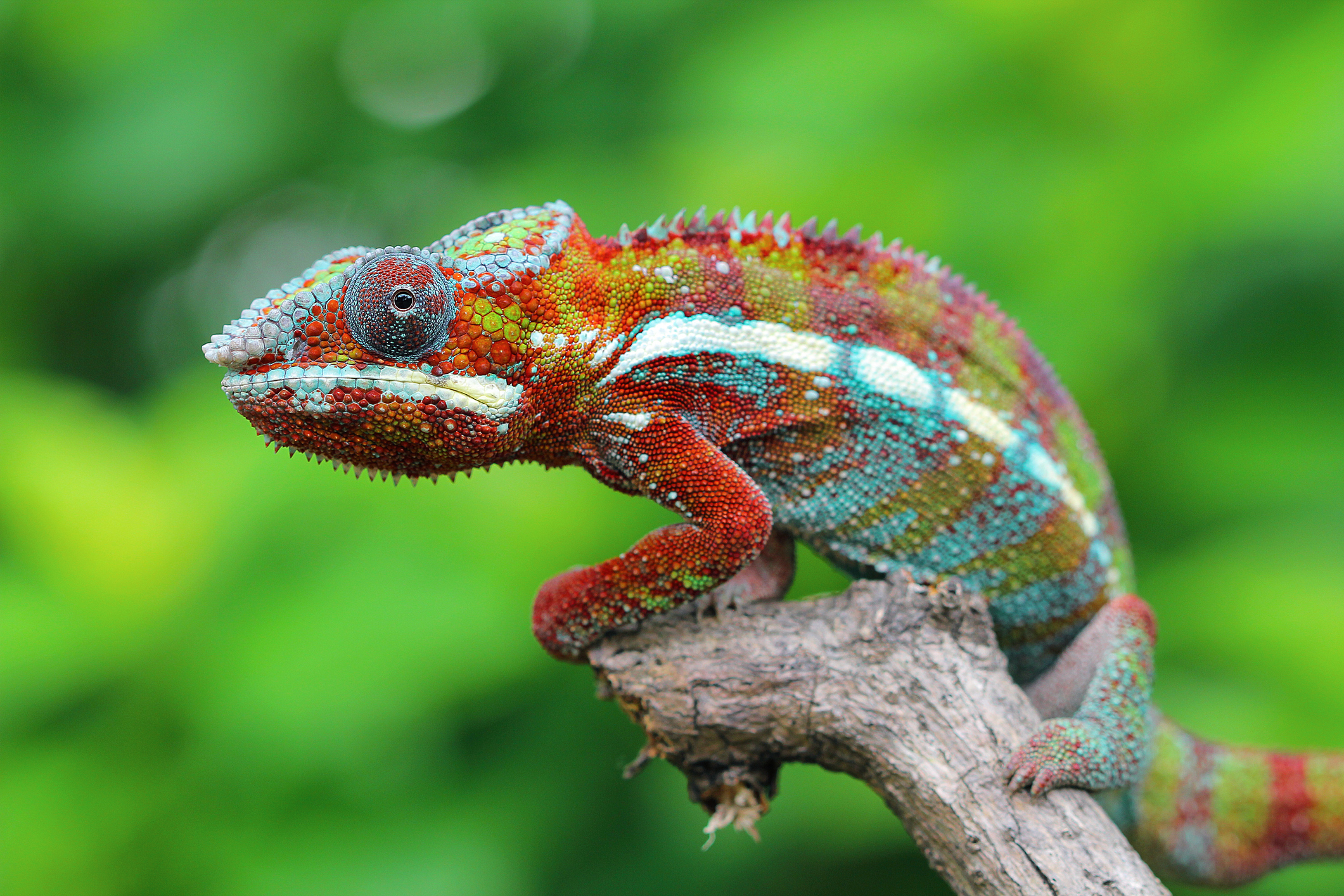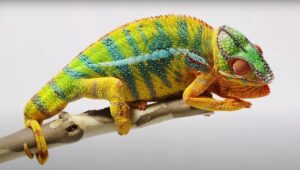Chameleons change color through the expansion and contraction of specialized cells called chromatophores. These cells contain pigments that reflect light differently when adjusted.
Chameleons possess a fascinating ability to shift their skin color, a feature that has intrigued scientists and enthusiasts alike. This remarkable color change is not just for camouflage as commonly believed, but also for communication and temperature regulation. The chromatophores in their skin work in layers to manage this process.
Underneath a transparent outer skin layer, chameleons have several layers of these pigment cells, and by changing the space between the chromatophores, they alter the wavelengths of light reflected off their skin, thus changing their color. This adaptation is a stellar example of nature’s ingenuity and has become a signature trait of these reptiles, reinforcing their identity in the animal kingdom as the masters of disguise.

Credit: www.shutterstock.com
The Mystique Of Chameleon Color Change
Chameleons fascinate with their ability to change color. This unique skill blurs the line between reality and magic. Many believe chameleons adapt colors for camouflage, communication, and temperature regulation. Let’s unravel the secrets behind the mystique of chameleon color change.
Chameleons In Popular Culture
Chameleons hold a special place in films, books, and folklore. They are often seen as masters of disguise. From children’s cartoons to high fantasy realms, chameleons embody adaptability and mystery.
- Pascal in Disney’s Tangled
- Comical sidekicks in animated series
- Symbols of change and insight in literature
Myths Versus Reality
Color change is not just about hiding from predators. It’s a complex process. Underneath their skin, chameleons have special cells called chromatophores. These cells house different pigments that expand and contract, changing the chameleon’s color:
| Layer | Function |
|---|---|
| Outermost | Reflects light and changes color |
| Middle | Contains pigment for yellow and red |
| Innermost | Has a deep blue or brown pigment |
This interplay of light and pigment creates the chameleon’s colorful display. Emotions, temperature, and light influence their color. This natural spectacle is about communication and survival.
Anatomy Of A Color-changing Reptile
Have you ever watched a chameleon shift colors? These remarkable reptiles perform color change like no other, fascinating onlookers with their adaptable camouflage. This incredible ability relies on their unique anatomy. Let’s dive into the anatomy of a chameleon and uncover the secrets held within their skin!
Unique Skin StructuresUnique Skin Structures
Chameleons possess extraordinary skin structures that set them apart from other reptiles. Their skin is made of several layers, each with a special role in color change. The outermost layer is transparent, allowing the layers beneath to shine through. Below this, are cells known as chromatophores, the true artists of color change.
Chromatophores are special pigment cells containing tiny sacs filled with different colors, which can expand or contract. These control the colors we see on a chameleon’s surface.
Layers That Make the MagicLayers That Make The Magic
- Epidermal Layer: The clear outer skin that covers chromatophores.
- Chromatophore Layer: Contains yellow and red pigments.
- Iridophore Layer: Reflective, it creates blues and greens depending on light.
- Melanophore Layer: Contains melanin, which affects lightness or darkness.
When a chameleon changes color, signals from its environment or body cause these layers to work together. The iridophore and melanophore layers reflect and absorb light, while the chromatophore layer adjusts the overall color pattern. Through the combination of these actions, chameleons can beautifully blend with their surroundings or communicate with other chameleons.
The Science Behind The Spectrum Shift
Ever wondered how a chameleon seamlessly blends with its surrounding? Behind this fascinating color change lies some complex science. Chameleons don’t just switch hues for camouflage. They also do it to regulate their temperature and communicate. Let’s unravel the layers of the science that powers this spectrum shift.
Chromatophores And Pigment Cells
The key players in the chameleon’s color transformation are special cells called chromatophores. These cells sit in layers under the chameleon’s skin. Each layer holds different pigment cells, contributing to the color change. Here’s a quick snapshot:
- Xanthophores and erythrophores: Top layers containing yellow and red pigments.
- Chromatophores: Middle layer with the brown pigment, melanin.
- Guianophores: Bottom layer that reflects blue and white.
When a chameleon’s mood changes, its body sends signals to expand or contract these cells. This action alters the color that they reflect.
Nanocrystals At Work
It’s not just pigments at play; chameleons also boast nanocrystals in their skin. Called iridophores, these cells contain tiny crystals. They act like prisms, reflecting light in varying wavelengths.
- Chameleon feels a change in the environment or its mood.
- The iridophores adjust the spacing of nanocrystals.
- Light reflects differently, causing a visible color change.
Depending on the spacing between these crystals, different levels of light reflection result in different color outcomes, giving the chameleon its dynamic range of hues.
More Than Mere Aesthetics: Functions Of Color Variation
The dazzling dance of colors displayed by chameleons is much more than a visual feast. Beyond their well-known ability to blend into their surroundings, chameleons use color variation to communicate, attract mates, and even regulate their body temperature. Let’s delve into the practical functions of these remarkable color changes.
Natural Camouflage
Chameleons have mastered the art of invisibility. Their skin changes colors to match their environment, hiding them from predators and prey. This skill involves a complex layer of cells beneath their skin called chromatophores. These cells expand or contract to show more or less pigment, blending the chameleon with its backdrop.
Communication And Mating Signals
Chameleons speak in colors. They flash distinct patterns to convey messages to other chameleons. During mating season, males display vibrant hues to woo females and to intimidate rivals. Vibrant colors signal health and strength, crucial for securing a mate.
Thermal Regulation
Their skin doesn’t just camouflage or communicate; it also helps control body temperature. On cooler days, chameleons darken to absorb more heat. In contrast, they turn lighter on hot days to reflect sunlight. This natural temperature management is vital for their survival.
The Role Of Emotions And Environment
The Role of Emotions and Environment is crucial in understanding how chameleons change color. These reptiles are well-known for their color-changing skin. The changes serve as a means to communicate and adapt. Let’s dive into the roles emotions and the environment play.
Stress And Aggression
Stress and aggression have immediate effects on a chameleon’s skin color. When chameleons feel threatened or are defensive, their skin turns into a darker shade. This serves as a warning to predators or rivals.
Darker colors can be a sign of discomfort or annoyance. During battles for territory or mating rights, chameleons display bold colors. These visual signals are vital for their communication.
Adapting To Surroundings
Chameleons use color change for camouflage and temperature regulation.
- Blend In: They change color to match their environment. This helps them hide from predators.
- Warm Up or Cool Down: Changing to a darker color absorbs more heat, while lighter colors reflect it away.
In warm sunny spots, they may switch to lighter colors. In cooler shaded areas, they become darker.

Credit: www.discoverwildlife.com
Lifespan Of Colors: When Chameleons Show Their True Colors
Chameleons are nature’s master artists, shifting their shades in a live canvas display. In the course of their lives, a chameleon’s colors narrate a vivid story about their growth, health, and mood. Understanding the Lifespan of Colors: When Chameleons Show Their True Colors unravels the mystery behind these colorful changes.
Growth And Age Effects
As chameleons grow, their colors become more vibrant and complex. Young chameleons typically showcase less diverse colors. As they mature, a kaleidoscope of colors emerges. Here’s what influences their color changes over time:
- Age: Color complexity increases with age.
- Hormones: Color depth fluctuates during different life stages.
- Mating: Males dazzle with colors to attract mates.
The Impact Of Health
Health not only affects how long chameleons live but also their color vibrancy. A healthy chameleon boasts bright and clear colors, which serve as a sign of well-being. Contrastingly, color dullness or darkening can signal health issues. Look at the nuances:
- Bright Colors: Indicate good health and vitality.
- Dark or Muddy Colors: Often a sign of stress or illness.
- Frequency of Change: Less frequent changes may mean health concerns.
Human Interaction And The Chameleon’s Color Palette
Chameleons are known for their captivating ability to change color. This remarkable skill helps them blend into their surroundings. But what happens when humans interact with these creatures? Let’s explore how chameleons adapt their color palette within the pet trade and captivity environments.
The Pet Trade
Humans have long been fascinated with chameleons, often bringing them into their homes as exotic pets. With vibrant colors and unique patterns, these reptiles make visually intriguing companions. When people choose chameleons as pets, the creatures face an entirely new world. New surroundings may trigger a color change, reflecting their health and mood. A calm chameleon can display bright, active colors, while a frightened or sick one may turn darker.
Stressors In Captivity
In captivity, chameleons can face many stressors. Improper handling, unfamiliar environments, and dietary changes affect their wellbeing. Stress can lead to more subdued or darker coloration. To ensure a chameleon remains vibrant, it is crucial to mimic their natural habitat. This includes regulated temperatures, ample space, and proper lighting. A stressed chameleon might exhibit dark patches, or even refuse to eat. Observing their color can help owners gauge their pet’s stress levels and overall health.
Understanding the chameleon’s color palette is not just fascinating—it’s also a window into their wellbeing in our homes and in captivity.
Credit: www.quora.com
Conservation Efforts To Protect Nature’s Master Of Disguise
Chameleons, famed for their color-changing abilities, face threats from deforestation and the illegal pet trade. Their survival hinges on active conservation efforts. These efforts focus on maintaining their natural habitats and enforcing laws that protect them. Through understanding and action, we can ensure these remarkable creatures thrive for generations.
Habitat Preservation
Preserving the natural environments where chameleons live is critical. Conservation groups work to safeguard these areas. They create protected reserves and promote reforestation. Educating local communities about the importance of chameleons helps too. They learn how these creatures balance ecosystems.
- Building protected reserves
- Promoting reforestation projects
- Educating local populations
Legal Protection
Lawmakers create policies to shield chameleons from harm. These laws control the extraction and trade of wild chameleons. They ensure only captive-bred animals are sold. Strict penalties deter poachers and smugglers. International agreements, like CITES, regulate trade across borders. This helps to stop illegal activities.
| Legal Measure | Purpose |
|---|---|
| National Laws | Control extraction/trade within countries |
| International Agreements | Manage trade between countries |
| Penalties | Deter illegal poaching/trading |
Frequently Asked Questions For How Do Chameleons Change Color
How Do Chameleons Actually Change Their Color?
Chameleons change color through specialized cells called chromatophores. These cells expand or contract to mix colors similarly to pixels on a screen.
What Triggers A Chameleon To Change Its Color?
Chameleons change color for communication, temperature regulation, and camouflage. Their mood, light, and environmental factors like humidity can also trigger color changes.
Are All Chameleons Able To Change Color?
Most chameleons can change color, but the range and intensity vary. Some species are more adept at changing their hues than others.
How Quickly Can A Chameleon Change Its Skin Color?
A chameleon can change its skin color in minutes, sometimes seconds, depending on the stimulus and the species’ capabilities.
Conclusion
Chameleons boast a remarkable ability to change color, a process driven by survival and communication. These captivating creatures use specialized cells and unique biological mechanisms to adapt their appearance. Understanding how chameleons shift their hues not only fascinates us but also underscores the complex beauty of nature.
Embrace the wonder of these adaptive reptiles and their colorful displays.


